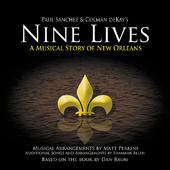NINE LIVES A MUSICAL ADAPTATION, VOLUME 1 by Colman deKay & Paul Sanchez
based on the novel by Dan Baum
Mystery Street 2011
Paul Sanchez producer
Wes Fontenot, Mark Bingham engineers Nine Lives
New Orleans' musical renaissance, so well documented in the HBO series Treme, has reached its apotheosis with this expansive project. Paul Sanchez, a versatile singer-songwriter who performs in dozens of different contexts around New Orleans with many of his cohorts, joined forces with lyricist Colman deKay and several local musician buddies to write forty songs based on Dan Baum's best selling novel, Nine Lives. Sanchez then enlisted over 100 musicians to realize this dream, and they took this three-ring circus into Piety Street Studios, where Sanchez - abetted by engineer Wes Fontenot and resident master of mixology Mark Bingham - proved an able ringmaster.
Baum's novel is tough to boil down because it concentrates less on narrative than in character development and point of view. The book focuses on nine disparate citizens of New Orleans as they experience life in the years framed by two hurricanes, Betsy (1965) and Katrina (2005). Nine Lives Vol. 1 presents the characters singing a little more than half the songs written for this adaptation. deKay and Sanchez, who used Baum's own words to unify the script, wisely chose to record these songs before mounting a stage production; this allowed them to concentrate on realizing each song fully as possible, without worrying about enforcing a narrative. The result works more as a great series of songs about New Orleans than as a souvenir cast album of show tunes.
The singing alone would make this recording a standout. John Boutte' opens the proceedings with "Fine In The Lower Nine," a slam-dunk anthem that will make history as this production's musical brand. Along with Trem star Wendell Pierce, Boutte' rolls out the sing-along R&B chorus about country life in the Lower Ninth Ward in 1965. "We're in our blue heaven," goes the out-chorus, in reference to local resident Fats Domino, "down on Deslonde Street." Given the devastation that was eventually visited on this neighborhood, it would be impossible to write this song today in any other context - but as a piece of theater documenting a way of life a half a century ago, it makes perfect sense.
Boutte' also sings on the finale, "Rebuild Renew", and contributes two songs, "Feel Like A Lady" and "To Be Continued". Other family members of this talented family - Lillian, Tricia, Peter, and Tanya Boutte' - also have key roles on Vol. 1. Sanchez, in the role of Dr. Frank Minyard, sings most of the songs and thus provides a strong continuity. Shamarr Allen, who wries, sings and plays trumpet, also produced two of the album's most important tracks, "House Of Dance And Feathers" and "We Are The Band." He is an invaluable resource - as is Alex McMurray, as Officer Tim Bruneau, rocking out on voice and guitar in "Jump Out Boys." McMurray makes crucial contributions on guitar and banjo throughout, while the ubiquitous pianist Tom McDermott is so perfectly cast that he acts as a shadow musical director for Sanchez. The late, legendary drummer Herman Roscoe Ernest III makes his last studio appearances in these tracks. And there are more star turns than I can list, by local favorites the Dixie Cups, Allen Toussaint, Irma Thomas, Walter "Wolfman" Washington, Andres Osborne, Harry Shearer and literally dozens of others.
The hero behind the scenes of Nine Lives is Matt Perrine, whose arrangements for a range of New Orleans settings provide shadow and light throughout this fascinating history. The mood and balance of the story told here skirt the unconscious depths of the imagination, a dreamscape of New Orleans based on things that actually happened to real people, now told as a story designed to strike a resonant chord in every listener. Perrine's nuanced genius and the broad palette of his own playing on tuba and bass bring operatic life to this tale. Of a city that, in the 19th century, was known for its presentations of opera, there could be no more fitting evocation.
John Swenson


